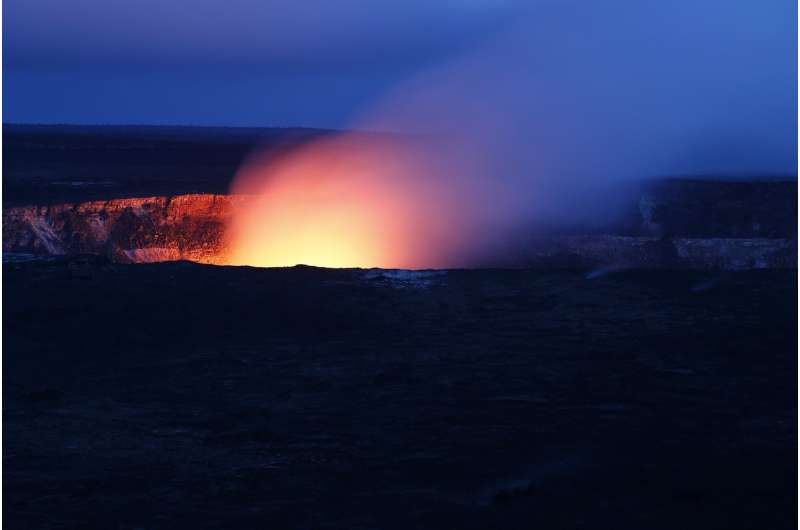
The Volcano Alert Level (VAL) system, standardized by the United States Geological Survey (USGS) in 2006, is meant to save lives and keep citizens living in the shadow of an active volcano informed of their current level of risk.
A new study published in Risk Analysis suggests that, when an alert remains elevated at any level above "normal" due to a period of volcanic unrest, it can cause a decline in the region's housing prices and other economic indicators. Because of this, the authors argue that federal policymakers may need to account for the effects of prolonged volcanic unrest—not just destructive eruptions—in the provision of disaster relief funding.
A team of geoscientists and statistical experts examined the historical relationship between volcano alerts issued by the United States Geological Survey (USGS) and regional economic growth for three of the country's most dangerous volcanoes: Washington State's Mount St. Helens, Hawaii's Kīlauea, and California's Long Valley Caldera.
They analyzed the effect of VALs and their predecessors (such as hazard alerts and volcano alerts) on local housing prices and business patterns over a 42-year period, from 1974 to 2016. The economic indicators used in the analysis included annual housing price, number of business establishments per 1,000 square kilometers, the number of employees per 1,000 inhabitants, and payroll per employee.
The team used econometric models to observe economic indicator trends during times when an increase in volcanic activity above "normal" led to a public alert. "Signs of volcanic unrest include ground deformation, rising C02 emissions, and increased earthquake frequency," says Justin Peers, East Tennessee State University.
Both lower and higher alert level notifications were shown to have short-term effects on housing prices and business indicators in all three regions. The most significant negative impacts were seen for California's Long Valley Caldera area from 1982-83 and 1991-97. Home to Mono Lake, Mammoth Mountain, and the very popular Mammoth Lakes ski area, this complex volcanic region has experienced prolonged episodic unrest.
Not all of the volcanic regions experienced a significant long-term economic impact from an elevated VAL. The greatest exception was Mount St. Helens. Peers suggests this could be due to "volcano tourism and close proximity to the major tech hub of Portland, Oregon." Despite catastrophic volcanic potential, the regional economy in the footprint of Mount St. Helens has benefited from tourism to the volcano—accelerated by the establishment of Mount St. Helens National Volcanic Monument in 1982.
The study's findings are consistent with those from other natural hazards studies that have documented temporary declines in housing prices following successive hurricanes, floods, and wildfires. With natural hazards, the mere presence of information about hazard potential in the form of a public alert level notification may have an adverse effect on local economies.
This sheds light on a systemic issue in disaster resilience, the authors argue. The federal government currently provides disaster relief for direct impacts of volcanic eruptions and other natural disasters, but limited or no assistance for the indirect effects experienced from long periods of volcanic unrest. Durations of volcanic unrest are often protracted in comparison to precursory periods for other hazardous events (such as earthquakes, hurricanes, and floods). As Peers points out, this makes the issue of disaster relief for indirect effects particularly important in high-risk volcanic regions.
For experts who study the risks of natural hazards, the team suggests they have developed a repeatable and reliable methodology to test hazard alert effects on local economies using publicly available federal U.S. business statistics. "This could be utilized to examine the impacts of all hazard alerts, such as those for wildfires or earthquakes," the authors write.
And for citizens, "we hope this research will help people better understand that the risks involved with living around a volcano are not entirely from the physical hazards associated with volcanism. It's more financially complicated than that," says Peers.
Explore further
Provided by Society for Risk Analysis
Citation: The potential economic impact of volcano alerts (2021, March 17) retrieved 17 March 2021 from https://ift.tt/3lqxJ5e
This document is subject to copyright. Apart from any fair dealing for the purpose of private study or research, no part may be reproduced without the written permission. The content is provided for information purposes only.
"impact" - Google News
March 17, 2021 at 02:52PM
https://ift.tt/3lqxJ5e
The potential economic impact of volcano alerts - Phys.org
"impact" - Google News
https://ift.tt/2RIFll8
Shoes Man Tutorial
Pos News Update
Meme Update
Korean Entertainment News
Japan News Update
Bagikan Berita Ini















0 Response to "The potential economic impact of volcano alerts - Phys.org"
Post a Comment